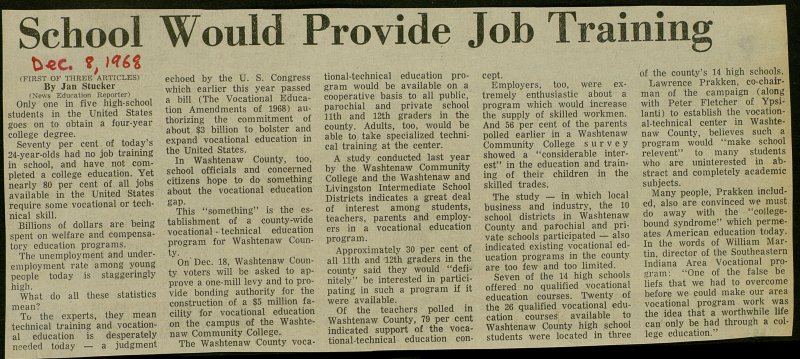School Would Provide Job Training

(FIRST OF THREE ARTICLES) Only one in five high-school students in the United States goes on to obtain a four-year college degree. Seventy per cent of today's 24-year-olds had no job training in school, and have not completed a college education. Yet nearly 80 per cent of all jobs avaüable in the United States require some vocational or technical skill. Billions of dollars are being spent on welfare and compensatory education programs. The unemployment and underemployment rate among young people today is staggeringly high. What do all these statistics mean? To the experts, they mean technical training and vocational education is desperately needed today - a judgment echoed by the U. S. Congress which earlier this year passed a bilí (The Vocational Education Amendments of 1968) authorizing the commitment of about $3 billion to bolster and expand vocational education in the United States. In Washtenaw County, too, school officials and concerned citizens hope to do something about the vocational education gap. This "something" is the establishment of a county-wide vocational - technical education program for Washtenaw County. On' Dec. 18, Washtenaw County voters will be asked to approve a one-mill levy and to provide bonding authority for the construction of a $5 million facility for vocational education on the campus of the Washtenaw Community College. The Washtenaw County tional-technical education program would be available on a cooperative basis to all public, parochial and private school llth and 12th graders in the county. Adults, too, would be able to take specialized technical training at the center. A study conducted last year by the Washtenaw Community College and the Washtenaw and Livingston Intermedíate School Districts indicates a great deal of interest among students, teachers, parents and employers in a vocational education program. Approximately 30 per cent of all llth and 12th graders in the county said they would "definitely" be interested in participating in such a program if it were available. Of the teachers polled in Washtenaw County, 79 per cent indicated support of the vocational-technical education cept. Employers, too, were extremely enthusiastic about a program which would increase the supply of skilled workmen. And 56 per cent of the parents polled earlier in a Washtenaw Community College s u r v e y showed a "considerable interest" in the education and training of their children in the skilled trades. The study - in which local business and industry, the 10 school districts in Washtenaw County and parochial and private schools participated - also indicated existing vocational education programs in the county are too few and too limited. Seven of the 14 high schools offered no qualified vocational education courses. Twenty of the 26 qualified vocational education courses available to Washtenaw County high school students were located in three of the county's 14 high schools. I Lawrence Prakken, I man of the campaign (along I with Peter Fletcher of I lanti) to establish the I al-technical center in I naw County, believes such a I program would "make school I relevent" to many students I who are uninterested in abstract and completely academie subjects. L Many people, Prakken included, also are convinced we must I do away with the "collegebound syndrome" which permeates American education today. In the words of William Martin, director of the Southeastern Indiana Área Vocational program: "One of the false be Üefs that we had to overeóme before we could make our area vocational program work was the idea that a worthwhile life can only be had through a college education." I
Article
Subjects
Ann Arbor News
Old News